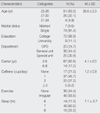Abstract
Purpose
This study was done to compare edema and pain after completing a nurse's daily shift and to examine the effects of self leg massage which was usually used for reducing nurses' lower extremity edema and pain after their shift.
Methods
The research design was a nonequivalent control group pretest-posttest design. Study subjects were 81 nurses
who took a self leg massage program created by the researcher. Self leg massage was done 15 times during 3 weeks. Data were collected from September 21 to October 31, 2007. The level of lower extremity edema was measured by ankle and calf circumference by a tapeline in cm and the pain score was measured by using a subjective numbering rating scale. Data were analyzed with the SPSS 12.0 program using statistics of repeated measures ANOVA.
Figures and Tables
References
1. American Pain Society Quality of Care Committee. Quality improvement guidelines for the treatment of acute pain and cancer pain. The Journal of the American Medical Association. 1995. 274:1874–1880.
2. Bureau of Labor Statistics. Reports on survey of occupational injuries and illness in 1998. 1999. Washington, DC: Bureau of Labor Statistics, US Dept of Labor..
3. Choi MA, Kim KS. Nursing Science. 1997. . Seoul: Seoul University Press.
4. Choi WK. Characteristics of musculoskeletal pain in nurses. 2005. Seoul: Yonsei University;Unpublished master's thesis.
5. Harmer PA. The effect of pre-performance massage of massage in stride frequency in sprinters. Athletic Training. 1991. 26:110–125.
6. Kant IJ, de Jong LC, van Rijssen-Moll M, Borm PJ. A survey of static and dynamic work postures of operating room staff. International Archives of Occupational and Environmental Health. 1992. 63:423–428.
7. Kim IH. A study on effect of foot reflex massage on mental and physical relaxation to adult women. 2005. Seoul: Sungshin Women's University;Unpublished master's thesis.
8. Kim KO. The effects of foot reflex to the comfort of long time standing female workers. 2000. Pusan: Pusan National University;Unpublished doctoral dissertation.
9. Kim SJ, Sung MS. Subjective symptom in fatigue in hospital nurses. Journal of Korean Academy of Nursing. 1998. 28:908–919.
10. Kim SO. A study of health condition and shift service of the nurse in general hospital. 1997. Seoul: Kyunghee University;Unpublished master's thesis.
11. Kim YS. Effects of the application of elastic compression stockings on edema and pain of lower extremities in hospital nurses. 2006. Daegu: Keimyung University;Unpublished master's thesis.
12. Ko HJ, Kim MA, Kwon YS, Kim JN, Park GM, Park JS. The fatigue experience of shift work nurses. Journal of Korean Academy of Community Health Nursing. 2004. 18:103–118.
13. Ko YS, Park MK. Effects of self-foot reflexology on fatigue and sleep states in women nurses. Journal of Korean Academy of Women's Health Nursing. 2007. 13:21–27.
14. Kwon YS. Survey on the knowledge of pain and the pain intervention of clinical nurses-focus in Daegu city and Kyungbuk province-. 2003. Daegu: Keimyung University;Unpublished master's thesis.
15. Lee EO, Lim NY, Park HA. Nursing, medical research and statistical analysis. 1998. Seoul: Soomoon Publishing.
16. Lee HJ. The effects of foot reflexologic massage on the hemodialysis patient's lower limbs edema, fatigue, and sleep. 2006. Seoul: Sungshin women's University;Unpublished master's thesis.
17. Lee JB. The effects of foot reflexology on fatigue in clinical nurses. 2002. Seoul: Hanyang University;Unpublished master's thesis.
18. Lee JT. Effect of musculoskeletal symptom on REBA and job stress in hospital worker. 2007. Suwon: Ajou University;Unpublished master's thesis.
19. Lee YM. Effect of self-foot reflexology massage on depression, stress responses and immune function of middle aged women. Journal of Korean Academy of Nursing. 2006. 36:179–188.
20. Lundberg U, Kadefors R, Melin B. Stress, muscular tension and musculoskeltal disorders. International Journal of Behavioral Medicine. 1994. 1:353–370.
21. McCaffery M, Pasero C. Pain: Clinical manual. 1999. 2nd ed.St. Louis: Mosby.
22. Min IY. Influence of foot reflexology massage on nurses' fatigue and their lower extremity edema. 2002. Daegu: Keimyung University;Unpublished master's thesis.
23. National Institute for Occupational Safety and Health. Musculoskeletal disorders and work place factors: A critical review of epidemiologic evidence for work related musculoskeletal disorders of the neck, upper extremity, and low back. 1997. Cincinnati (OH): NIOSH, US Dept of Health and Human Services;Report no 97-141, July, 1997.
24. Oh JH, Kwun WH, Suh BY. Clinical Features of Chronic Lower Ischemia. Journal of the Korean Society for Vascular Surgery. 1998. 15:253–260.
25. Park IK, Paik YS, Kim HS, Kim IK, Song KS. . Sport massage for health promotion of modern people. 2006. 5th eds. Daejeon: Chungnam National University Press.
26. Shin YK, Lee CU. Depressive disorder in patients with chronic pain. Journal of the Korean Pain Society. 2002. 15:110–115.
27. Sung KS. Using of massage for health management. Sport Science. 2005. 93:80–85.
28. Katztoshi T. Acupressure and massage viewing on graphic. 2004. Seoul: Eye & Heart Press.
29. Trinkoff AM, Storr CL, Lipscomb JA. Physically demanding work and inadequate sleep, pain medication use, and absenteeism in registered nurses. Journal of Occupational and Environmental Medicine. 2001. 43:355–363.




 PDF
PDF ePub
ePub Citation
Citation Print
Print









 XML Download
XML Download